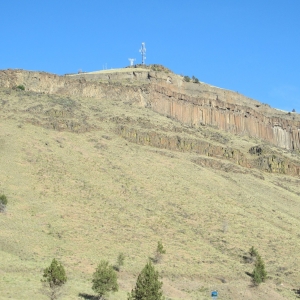This is Eileen Wray-McCann for Circle of Blue. And this is What’s Up with Water, your “need-to-know news” of the world’s water, made possible by support from people like you.
—
There was confusion last week over the status of a controversial new hydropower dam on on a major tributary of the Nile. News reports said that Ethiopia had begun filling the reservoir behind the Grand Ethiopian Renaissance Dam before first securing a water-sharing agreement with downstream neighbors Egypt and Sudan. Ethiopia denied the reports. A security analyst told the Associated Press that satellite photos suggesting the accumulation of water behind the nearly complete dam should be attributed to seasonal rains and not government action. Ethiopia, Egypt, and Sudan have tried for years to broker a deal on how to fill and operate the massive dam. Ethiopia views the dam as a crucial energy source. Only 45 percent of the country’s population has access to electricity. Egypt, long the dominant power in the region, fears losing control over a river that provides nearly all of its water. Egypt’s Foreign Minister previously warned that filling the dam prior to an agreement would be a destabilizing move for the region and could lead to conflict. Ethiopia has said that even without a deal, it would begin filling the reservoir by the end of the month.
—
Communities along the Yangtze River in southern China continue to endure the worst flooding in decades. Some 44 million people have been evacuated this summer due to high waters. Cities such as Wuhan on are high alert. Economic damage is mounting as well. The Nikkei Asian Review forecasts losses at $12 billion.
—
In the Great Lakes region of the United States, rising water levels have eased a bit. After several months of promising to reach record-high levels, experts now say it is unlikely that lakes Michigan and Huron will break the 1986 record. MLive reports that the rapid rise in water levels was slowed in recent weeks by drier-than-average conditions. Scientists now expect the lakes to maintain their current levels before beginning to recede next month.
—
This week, Circle of Blue reports on an experiment in Phoenix that is an alternative to shutting off water to homeowners who are behind on their bills. It involves a simple disk that’s no larger than a quarter. But Kathryn Sorensen and the staff at Phoenix Water Services Department think it could address one of the utility’s most vexing problems.
The device is a flow restrictor, and it is inserted where the meter connects to the service line. A tiny hole in the center of the disk can severely constrict the passage of water, cutting the flow into a home to a trickle. Phoenix believes that it is the first U.S. utility to use flow restrictors instead of shutting off water to households that are behind on their bills. The city began using the devices in early March, but removed them a few weeks later in response to the pandemic.
Sorensen, the director of Phoenix Water, views flow restrictors as a middle ground: they help the utility ensure that its revenue comes in, while not completely cutting off service to those who don’t – or can’t pay. It’s a balancing act required of utilities across the country, who are juggling with the rising cost of water and the limits of customers beset by the coronavirus, an economic recession, and the worst unemployment since the Great Depression. Sorenson acknowledged the consequences for hygiene and health. She told Circle of Blue “We’re moving to a world where disconnections are more and more problematic. We’re hoping this is a reasonable compromise.”
Phoenix used to stop water to households and businesses that did not pay their bills. Most water utilities do the same, but many have suspended that practice during the pandemic. Utilities justify shutoffs as financial self-preservation: a tool to ensure that customers pay for the service and the utility has enough revenue to operate. Utilities generally cover their costs through customer payments. But shutoffs are also controversial. The counter argument is that disconnecting water deprives the poorest residents access to a necessity that the United Nations has declared a human right. Handwashing and hygiene requirements have become more pronounced in the last four months as the coronavirus has turned a spotlight on health and environmental inequalities in this country.
Even before the pandemic, Sorensen said, Phoenix Water had started to review its operating procedures for fairness and equity. In doing so, the water department started tinkering with flow restrictors, which Sorensen had heard about from jurisdictions in Australia and in Cape Town. Phoenix water department staff designed and tested their own prototypes — initially made from a fibrous material and then stainless steel — before contracting out the manufacturing. The department’s citizen advisory committee endorsed the trial run.
The water department serves roughly 400 thousand residential accounts. In March, it started installing the flow restrictors at about 600 homes where water was off at the time. The devices were used only for single-family homes. The department’s assistant water services director, Troy Hayes, said that flyers, door hangers, and mail inserts informed the residents about the project.
The experiment lasted only a few weeks. Revenue enforcement took a back seat as the pandemic pressed the immediate need for adequate water. Sorensen acted on her emergency powers and suspended penalties for late payments. The flow restrictors were removed and water service was restored to the 600 homes.
The flow restrictor experiment reflects Phoenix’s generally sensitive approach to the complexity of supplying water to a large and diverse community living in a harsh climate. The utility’s tiered rates ensure inexpensive water for those who use water sparingly. Phoenix has the most affordable water rates of the 30 U.S. cities in Circle of Blue’s pricing survey.
But the water restrictors have their critics. Advocacy groups opposing the devices argue that even though they are better than no water at all, such severe restrictions fail to uphold human dignity. Water is reduced to a trickle. Tasks that used to take seconds, now take much, much longer. The penalty is time.
Jim Swanson is deputy director of meter field operations. He said that the 1.3 millimeter hole in the Phoenix device is calibrated so that the water flow is limited to less than half a gallon per minute. The maximum flow rate through a typical residential meter is between 20 and 30 gallons per minute, though the rate at the faucet is much lower.
In practice, the change is dramatic. Under normal circumstances, filling a glass of water would take about two seconds. With a flow restrictor, said Swanson, filling that glass takes 20 or 30 seconds. Showers become splash baths. It’s enough water for subsistence, but not enough for things like filling a pool and watering a lawn.
The experiment has flown under the radar, but it has not gone unnoticed. Hayes said that about a half dozen utilities contacted Phoenix to ask about the flow restrictors. Phoenix developed its own devices, but for utilities interested in the concept, flashier options are coming to market. Two leading water equipment manufacturers — Badger Meter and Mueller Systems — sell meters with technology that allows utilities to shut off water remotely, via a cellular signal. A higher-end Badger model launched earlier this year comes with three pre-set options: open, closed, and partially closed. The partially-closed setting restricts flow similar to the device Phoenix developed. The design is pitched as a cost saver. With remote access, utilities will not have to send a truck and crew to someone’s home to adjust the water flow. However, there is a significant upfront expense. Badger’s plus model, at $500 to $600 per meter, costs three times more than the basic version.
At this point, utilities are lining up to sample the product. But Badger’s director of utility marketing, told Circle of Blue the utilities are not yet making bulk purchases. He said “They want to try before they buy.”
—
And that’s What’s Up With Water from Circle of Blue, which relies on your support for independent water news and analysis. Please visit
circleofblue.org and make a difference through your tax-deductible donation.





